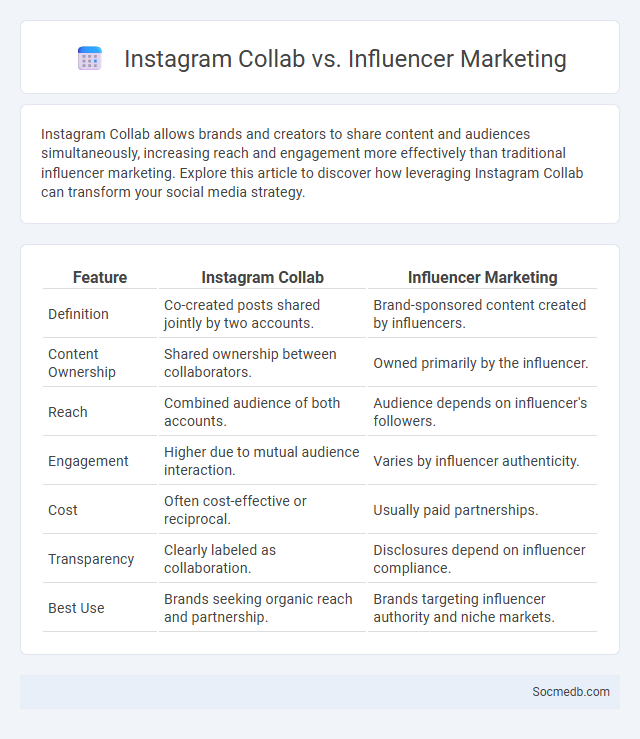
Photo illustration: Instagram Collab vs Influencer Marketing
Instagram Collab allows brands and creators to share content and audiences simultaneously, increasing reach and engagement more effectively than traditional influencer marketing. Explore this article to discover how leveraging Instagram Collab can transform your social media strategy.
Table of Comparison
| Feature | Instagram Collab | Influencer Marketing |
|---|---|---|
| Definition | Co-created posts shared jointly by two accounts. | Brand-sponsored content created by influencers. |
| Content Ownership | Shared ownership between collaborators. | Owned primarily by the influencer. |
| Reach | Combined audience of both accounts. | Audience depends on influencer's followers. |
| Engagement | Higher due to mutual audience interaction. | Varies by influencer authenticity. |
| Cost | Often cost-effective or reciprocal. | Usually paid partnerships. |
| Transparency | Clearly labeled as collaboration. | Disclosures depend on influencer compliance. |
| Best Use | Brands seeking organic reach and partnership. | Brands targeting influencer authority and niche markets. |
Understanding Instagram Collab: Definition and Features
Instagram Collab is a feature that allows two users to co-author posts or Reels, sharing visibility and engagement on both profiles. It enables shared content to appear in followers' feeds from both collaborators, optimizing reach and audience interaction. Key features include joint tagging, shared insights, and synchronized likes and comments, enhancing collaborative content strategies.
What is Influencer Marketing? Core Concepts
Influencer marketing involves collaborating with individuals who have a large, engaged audience on social media platforms to promote products or services authentically. Core concepts include identifying relevant influencers, leveraging their credibility to enhance brand awareness, and driving targeted consumer action through sponsored content or endorsements. This strategy capitalizes on the trust and influence influencers hold within their communities to deliver measurable marketing results.
Exploring Collaboration on Instagram: Types and Benefits
Exploring collaboration on Instagram involves various types such as influencer partnerships, brand takeovers, and co-created content, which significantly enhance audience reach and engagement. These collaborations leverage the combined follower base and creative resources, resulting in increased brand visibility and authentic user interaction. Benefits include improved trust between brands and consumers, elevated content diversity, and amplified marketing effectiveness through targeted campaigns.
Instagram Collab vs Influencer Marketing: Key Differences
Instagram Collab enables brands and creators to share content transparently, enhancing reach by displaying co-authors on posts and reels, which boosts authentic engagement and trust. Influencer marketing usually involves brand partnerships where influencers promote products through sponsored posts, often emphasizing follower count and influencer persona rather than content co-creation. The key difference lies in Instagram Collab's collaborative post visibility and joint audience interaction, whereas traditional influencer marketing focuses more on single-party content endorsement.
Audience Reach: Which Method Maximizes Engagement?
Social media platforms like Instagram, TikTok, and Facebook employ unique algorithms that prioritize content based on user interactions, making targeted audience reach crucial for maximizing engagement. Utilizing data-driven advertising tools, such as Facebook Ads Manager and Instagram Insights, allows marketers to refine demographics, interests, and behaviors for optimized content delivery. Influencer collaborations and authentic storytelling further amplify reach, driving higher engagement rates across diverse audience segments.
Authenticity and Trust: Collaboration vs Influencer Strategies
Authenticity and trust are crucial for effective social media engagement, with collaboration strategies fostering genuine connections between brands and audiences through shared values and transparent communication. Influencer strategies can boost visibility but often risk perceived insincerity if partnerships feel forced or overly commercialized. Your brand's success depends on balancing collaborative efforts that build trust with influencers who genuinely align with your message.
Cost Comparison: Collab, Influencer Marketing, and Partnerships
Social media marketing costs vary significantly across collaboration types, with influencer marketing often demanding higher budgets due to influencer fees and content creation expenses, typically ranging from $100 to $10,000+ per post depending on follower count and engagement rates. Collaborations, such as co-branded campaigns or joint ventures, may incur moderate costs primarily involving shared promotional efforts and resource allocation rather than direct payments. Partnerships, especially long-term brand alliances, often focus on mutual benefit strategies or revenue shares, resulting in lower upfront costs but requiring ongoing commitments and performance tracking for optimal ROI.
Measuring Success: Metrics for Each Approach
Measuring success on social media involves analyzing key metrics tailored to your specific strategy: engagement rate, follower growth, and reach quantify audience interaction while click-through rate (CTR) and conversion rate reveal the effectiveness of promotional campaigns. Tracking impressions and share of voice provides insights into brand visibility, whereas sentiment analysis gauges the overall perception of your content. Prioritizing these data points ensures your social media efforts align with business goals and maximize return on investment.
Choosing the Right Strategy for Your Brand
Selecting the right social media strategy for your brand involves identifying your target audience and aligning content with their preferences and platform behaviors. Analyzing competitor activity and leveraging data analytics tools ensures content reaches the right demographics, maximizing engagement and conversion rates. Consistent brand messaging across channels like Instagram, Facebook, LinkedIn, and TikTok reinforces brand identity and drives a cohesive customer experience.
Future Trends: Evolving Instagram Partnerships and Influencer Tactics
Future trends in social media highlight evolving Instagram partnerships that leverage micro-influencers and AI-driven analytics to enhance brand authenticity and engagement. Marketers are shifting towards long-term collaborations, focusing on niche audiences and data-backed content strategies to maximize ROI. You can expect influencer tactics to increasingly prioritize personalized experiences and real-time interaction to stay relevant in competitive digital landscapes.
 socmedb.com
socmedb.com